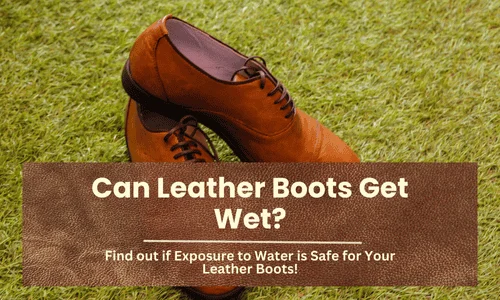Leather boots are a stylish and durable footwear choice, but many people wonder how they hold up when exposed to water. Whether you’re caught in the rain or stepping through puddles, knowing how water affects leather is crucial for keeping your boots in great condition. This article explains what happens when leather gets wet, how to protect your boots, and what to do if they do get soaked.

What Happens When Leather Boots Get Wet?
Leather is a natural material that can be sensitive to moisture. When leather boots get wet, the water can seep into the fibers, causing them to swell and weaken. As the leather dries, it can shrink, leading to stiffness, cracks, and even warping. Over time, repeated exposure to water can fade the color and damage the finish, reducing the lifespan of your boots.
Are Leather Boots Water-Resistant or Waterproof?
Leather boots are naturally somewhat water-resistant, but they are not fully waterproof unless specially treated. Full-grain leather and oil-tanned leather offer better water resistance due to their dense fibers and finishes. However, untreated leather will absorb water, which can lead to damage. Waterproof leather boots usually have treatments or membranes added to make them more resistant to water. It’s important to understand the difference and choose the right type of boot for your environment.
How to Protect Leather Boots from Water Damage?
Protecting leather boots from water is easier than repairing them after damage. Start by applying a waterproofing spray designed for leather. This creates a protective barrier that repels water. Leather conditioners are also helpful because they keep the material soft and flexible, reducing the risk of cracking. Regular cleaning with a soft brush and storing boots in a dry, cool place will also extend their life.
What to Do If Your Leather Boots Get Wet?
If your leather boots get wet, act quickly. First, blot off excess water with a clean, dry cloth. Do not use direct heat like hair dryers or heaters, as this can dry out and crack the leather. Instead, stuff the boots with newspaper or a towel to help them dry slowly and maintain their shape. Once dry, apply a leather conditioner to restore moisture and flexibility. Avoid wearing wet boots, as this can stretch and distort the leather.
Best Leather Types for Wet Conditions
Some types of leather handle moisture better than others. Oil-tanned leather is more resistant to water because it has been treated with oils and waxes, making it more durable in wet conditions. Full-grain leather, when properly treated, also holds up well. Boots specifically designed for outdoor or work use often include waterproofing treatments that make them suitable for wet environments.
Final Takeaways
Leather boots can handle occasional exposure to water, but they are not completely waterproof without treatment. Proper care, such as applying waterproof sprays and conditioners, can help protect your boots from moisture damage. If they do get wet, drying them carefully and conditioning them afterward will help maintain their quality. With the right care, leather boots can last for many years, even in unpredictable weather.
- How to Wear an Oversized Leather Jacket? Style Tips for a Casual Look - August 6, 2025
- How to Fold a Leather Jacket? - August 5, 2025
- How Should a Leather Jacket Fit a Woman? - August 1, 2025



